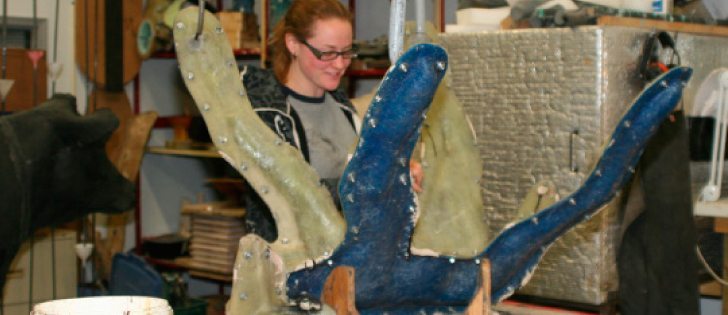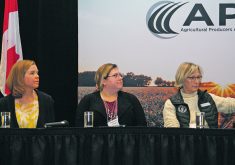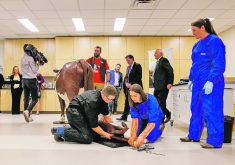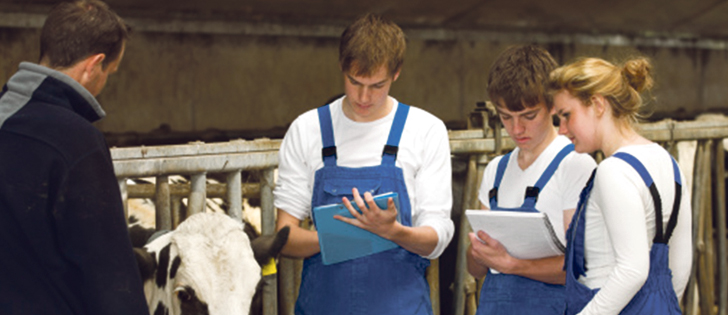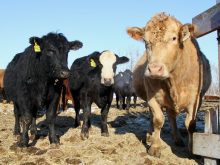Better for animals | Creating a replica, including organs, enables veterinary students to practise without causing stress to real animals
An unconventional marriage between science and art has conceived an unusual teaching model for veterinarians.
Alister Cribb, dean of the University of Calgary’s veterinary faculty, approached his neighbour, Russ Gray, in 2009 to build an interactive display of the back half of a cow with a calf inside. He wanted to show children at Aggie Days where baby calves come from.
Gray asked his friend, Bryan Pfahl, to help. The two men had 30 years experience as movie and television prop men and designers and could see there was a real need to supply advanced teaching tools to veterinary students.
Read Also

Farming Smarter receives financial boost from Alberta government for potato research
Farming Smarter near Lethbridge got a boost to its research equipment, thanks to the Alberta government’s increase in funding for research associations.
In 2010, they formed Veterinary Simulator Industries to design and build anatomically correct livestock models of horses, cattle and dogs, which have been sold to schools in 26 countries.
“Pretty much all the sales we have made to date came from people who found us,” said Pfahl.
Other simulators are available, but Gray and Pfahl’s are life-like, full-sized models made from epoxy resin, which can include interchangeable internal organs so that students can practise palpations before moving to the real thing. It has saved research animals a lot of stress and discomfort.
“There is nothing better to learn from than the real animal, but they are not always the best thing to teach with,” said Pfahl.
Simulators have been used before, but realistic models encourage students to become more engaged and careful with what they are doing.
“This isn’t going to replace the real one. It is a transition,” said Gray.
More schools are setting higher welfare standards for research animals, so the timing was right for introducing these kind of simulators.
The partners worked with a local sculptor and anatomists at the university, to develop the first prototypes, which took about a year. They created organs by studying preserved specimens.
They offer Quarter horses and beef and dairy cows. Dog and pig models were recently added.
The dairy cow is a full sized Holstein built with help from local veterinarians Gordon Atkins and David Chalack.
“Our Holstein is a 97-point true type Holstein, so it has been scrutinized,” said Gray.
They questioned whether they should build a life-sized Holstein because it was more expensive to build and ship to customers around the world.
“It turns out if you are in Liverpool, England, or you are in Wisconsin or Ontario, you want a Holstein. The conformation is certainly different,” said Pfahl.
The ideas never stop, and veterinarians continue to offer suggestions that can be challenging to construct.
Their goal is to create a perfect specimen, but sometimes alterations are made because internal organ placement is complex. For example, finding the right material to replicate the strength and feel of intestines has been a challenge.
The bovine uterus also proved to be more complicated than expected. It needs to be placed correctly and must be strong enough to withstand an inexperienced student’s probing.
They have created a uterus with a 60-day-old fetus to teach pregnancy checking, as well as a full-term calf for reproductive studies. These fit inside the cow, and the instructors can turn the body into different malpresentations so the students can learn how to deliver them safely.
“They can birth that Holstein five or 10 times. When they get around a real cow, they know what to do now,” said Gray.
The calf has a skeleton with joints that move correctly. It is not a puppet. It has a mouth that opens and an esophagus, so students can learn to insert a feeding tube.
It weighs about 50 pounds. The partners had considered making it the correct weight, but students could not handle the heavier model and started to damage it.
They have also built dogs’ legs with shoulders or hips attached to teach bandaging and sling techniques. Another project is a spay model that includes the dog’s uterus, ovaries, kidneys, bladder and ligaments.
“These are good for testing. If you have three of these and all your students run through it, it is all the same,” said Gray.
Suture kits that mimic the layers of skin are also available to teach stitching techniques.
They were recently commissioned to build heads of cattle and pigs to teach proper euthanasia techniques. The head will open so the operator can see where the captive bolt went to ensure it was positioned properly in the brain. There has been particular interest from the hog industry because of the wave of deaths attributed to porcine epidemic diarrhea in Canada and the United States.
The company has also been asked to consider building a sheep model so that students can learn to sort out tiny heads and an assortment of legs in dystocia cases when there are multiples inside the ewe.
As well, the partners are thinking about creating a horse’s head with veins and a reservoir of blood so students can learn to insert a needle correctly when doing a venapuncture.
Their biggest challenge in this market driven business is stepping up production. They are in a 2,500 sq. foot space in northeastern Calgary and could double that and increase their staff if they could find people with the desirable skill sets.
It helps if employees are artistic.
“We tell them the most interesting thing they will ever sculpt here is a cow’s uterus,” said Pfahl.
The company also needs additional funding to develop special prototypes and assurance that here is commercial interest so it can recover its costs.
The partners have received grants from the Alberta Livestock and Meat Agency as well as Growing Forward 2.
They have learned how different this business is from the film industry, where image and illusion are everything.
“This is the most important industry of all. This is what we eat. Not only are we dealing with the agriculture industry, we are dealing with education, and that’s something that I want to tell people,” said Pfahl.
“The movies are all fluff.”




